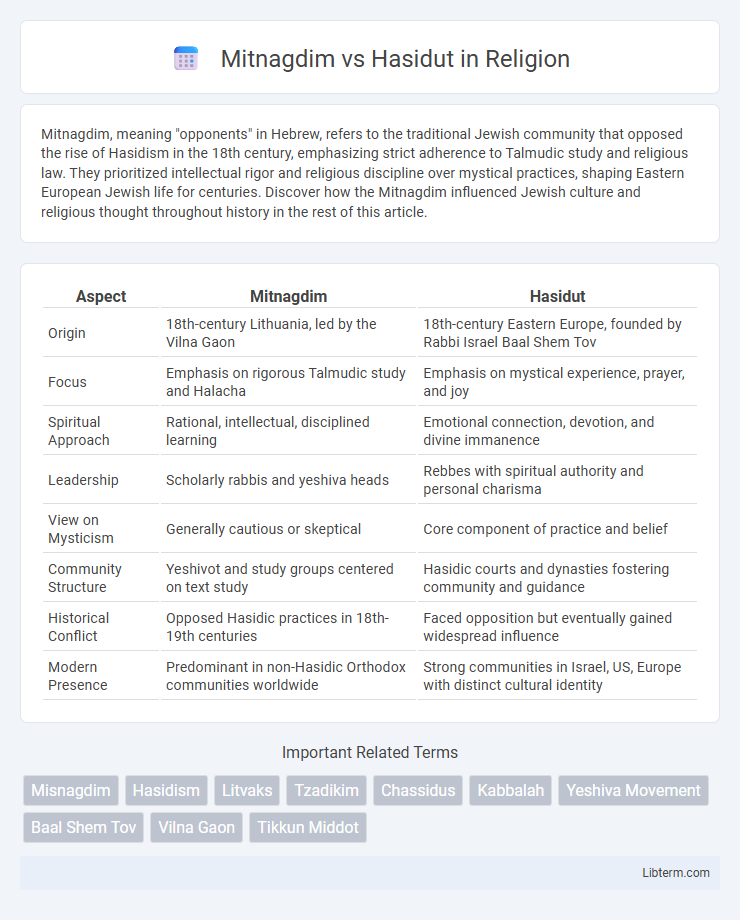Mitnagdim, meaning "opponents" in Hebrew, refers to the traditional Jewish community that opposed the rise of Hasidism in the 18th century, emphasizing strict adherence to Talmudic study and religious law. They prioritized intellectual rigor and religious discipline over mystical practices, shaping Eastern European Jewish life for centuries. Discover how the Mitnagdim influenced Jewish culture and religious thought throughout history in the rest of this article.
Table of Comparison
| Aspect | Mitnagdim | Hasidut |
|---|---|---|
| Origin | 18th-century Lithuania, led by the Vilna Gaon | 18th-century Eastern Europe, founded by Rabbi Israel Baal Shem Tov |
| Focus | Emphasis on rigorous Talmudic study and Halacha | Emphasis on mystical experience, prayer, and joy |
| Spiritual Approach | Rational, intellectual, disciplined learning | Emotional connection, devotion, and divine immanence |
| Leadership | Scholarly rabbis and yeshiva heads | Rebbes with spiritual authority and personal charisma |
| View on Mysticism | Generally cautious or skeptical | Core component of practice and belief |
| Community Structure | Yeshivot and study groups centered on text study | Hasidic courts and dynasties fostering community and guidance |
| Historical Conflict | Opposed Hasidic practices in 18th-19th centuries | Faced opposition but eventually gained widespread influence |
| Modern Presence | Predominant in non-Hasidic Orthodox communities worldwide | Strong communities in Israel, US, Europe with distinct cultural identity |
Origins of the Mitnagdim and Hasidut Movements
The Mitnagdim movement originated in the 18th century as a response to the emerging Hasidut movement, emphasizing rigorous Talmudic study and strict adherence to traditional Jewish law. Hasidut began in Eastern Europe, founded by Rabbi Israel Baal Shem Tov, promoting mystical spirituality and joyous worship as pathways to God. The divergent origins highlight contrasting approaches: Mitnagdim's focus on intellectualism and scholarship versus Hasidut's emphasis on emotional devotion and mystical experience.
Foundational Beliefs and Religious Philosophies
Mitnagdim emphasize rigorous Talmudic study and intellectual analysis, prioritizing halakhic precision and ethical discipline, in contrast to Hasidut's focus on mysticism, spiritual experience, and emotional connection to God through prayer and joy. The Mitnagdim reject the charismatic leadership and ecstatic worship styles of Hasidut, stressing the supremacy of Torah study as the path to divine service. Hasidut, founded by the Baal Shem Tov, introduces concepts like divine immanence and devekut (cleaving to God), which Mitnagdim perceive as deviations from normative rabbinic Judaism.
Key Figures: Vilna Gaon vs. Baal Shem Tov
The Vilna Gaon, a prominent leader of the Mitnagdim, emphasized rigorous Talmudic study and intellectual clarity, opposing the emotional and mystical approach of Hasidut pioneered by the Baal Shem Tov. The Baal Shem Tov introduced Hasidut as a spiritual revival movement focusing on piety, joy, and the immanence of God in daily life, contrasting the Mitnagdim's strict adherence to traditional scholarship. This fundamental difference in focus between the Vilna Gaon and the Baal Shem Tov shaped the development and tensions between these two influential Jewish movements.
Differences in Prayer and Worship Practices
Mitnagdim emphasize precise, intellectual prayer with a strong focus on textual study, aiming for clarity and concentration during worship. Hasidut incorporates lively, emotional singing, spontaneous prayer, and mystical meditations to create a deeply spiritual and communal experience. These differing approaches reflect Mitnagdim's preference for structured, rational devotion versus Hasidut's embrace of passionate, heartfelt worship.
Attitudes Toward Mysticism and Kabbalah
Mitnagdim traditionally approached mysticism and Kabbalah with skepticism, emphasizing rational study of Talmud and halacha over esoteric practices. Hasidut embraced Kabbalistic concepts, integrating mystical spirituality and divine immanence into daily prayer, ethical conduct, and community life. The divide centered on the Mitnagdim's caution toward potentially unchecked mystical enthusiasm versus the Hasidic focus on personal spiritual experience and joy.
Torah Study and Educational Approaches
Mitnagdim emphasize rigorous Talmudic study, analytical reasoning, and intellectual discipline in Torah education, focusing on in-depth comprehension and precise halachic methodology. Hasidut integrates mystical teachings and spiritual experience into learning, fostering emotional connection and devotion alongside traditional texts. Both approaches shape distinct educational frameworks: Mitnagdim prioritize structured learning and debate, whereas Hasidut encourage heartfelt engagement and communal worship.
Community Structure and Leadership
Mitnagdim communities emphasize centralized rabbinic authority and a hierarchical leadership structure led by learned scholars and prominent rabbis, fostering strict adherence to Talmudic study and halachic rigor. Hasidut features charismatic rebbes who serve as spiritual leaders and intermediaries, creating a more personal and communal bond between leader and followers within tightly-knit Hasidic courts. The Mitnagdim prioritize formal study halls (yeshivot) and communal councils, whereas Hasidut centers around the rebbe's court, blending spiritual guidance with communal decision-making.
Historical Conflicts and Notable Events
The Mitnagdim and Hasidut represent two distinct Jewish movements that emerged in the 18th century, with the Mitnagdim opposing Hasidic spiritual innovations and emphasizing traditional Talmudic study. Historical conflicts peaked when the Vilna Gaon, leader of the Mitnagdim, issued excommunication orders against Hasidim, viewing their mystical practices as heretical. Notable events include the suppression of Hasidic communities by Mitnagdim authorities and the eventual gradual acceptance and coexistence of both groups in Eastern European Jewish society.
Lasting Impacts on Jewish Life and Tradition
The Mitnagdim and Hasidut movements have profoundly shaped Jewish religious practice and cultural identity, with the Mitnagdim emphasizing rigorous Talmudic study and intellectual rigor, while Hasidut introduced mystical spirituality and communal joy into worship. The enduring influence of Mitnagdim is evident in the prominence of scholarship-focused yeshivas and rationalist approaches in modern Orthodox communities, whereas Hasidut's legacy persists in vibrant, close-knit Hasidic dynasties that prioritize emotional connection and worship through song and dance. These divergent yet complementary traditions continue to enrich global Jewish life, balancing analytical study with spiritual fervor.
Modern Perceptions and Ongoing Influence
The Mitnagdim, emphasizing rigorous Talmudic study and rationalism, contrast with Hasidut's focus on mysticism and spiritual fervor, shaping diverse contemporary Jewish identities. Modern perceptions often view Mitnagdim as guardians of traditional scholarship while Hasidut inspires vibrant community life and emotional devotion. Their ongoing influence is evident in educational institutions, synagogue practices, and cultural expressions within global Orthodox Judaism.
Mitnagdim Infographic

 libterm.com
libterm.com